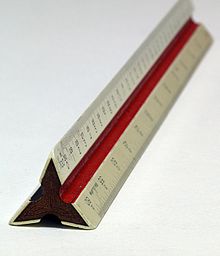Straightedge
This article includes a list of references, related reading, or external links, but its sources remain unclear because it lacks inline citations. (May 2010) |

A straightedge is a tool with an edge free from curves, or straight, used for transcribing straight lines, or checking the straightness of lines. If it has equally spaced markings along its length, it is usually called a ruler.
Straightedges are used in the automotive service and machining industry to check the flatness of machined mating surfaces.
True straightness can in some cases be checked by using a laser line level as an optical straightedge: it can illuminate an accurately straight line on a flat surface such as the edge of a plank or shelf.
A pair of straightedges called winding sticks are used in woodworking to amplify twist (wind) in pieces of wood.
Compass-and-straightedge construction
An idealized straightedge is used in compass-and-straightedge constructions in plane geometry. It may be used:
- Given two points, to draw the line connecting them.
- Given a point and a circle, to draw either tangent.
- Given two circles, to draw any of their common tangents.
It may not be marked or used together with the compass so as to transfer the length of one segment to another.
It is possible to do all compass and straightedge constructions without the straightedge. That is, it is possible, using only a compass, to find the intersection of two lines given two points on each, and to find the tangent points to circles. It is not, however, possible to do all constructions using only a straightedge. It is possible to do them with straightedge alone given one circle and its center.
See also
References
- Wayne R. Moore, Foundations of Mechanical Accuracy, Moore Special Tool Company, Bridgeport, CT (1970)
